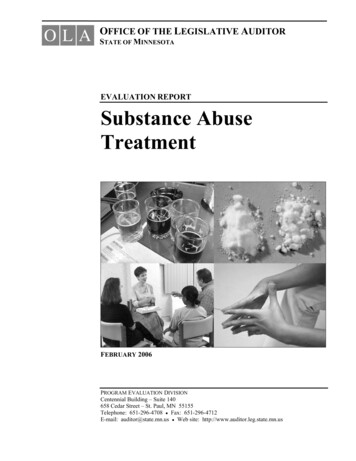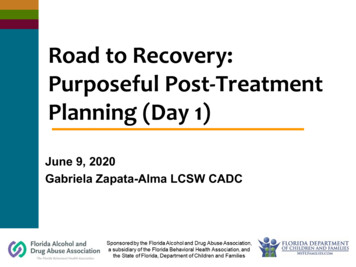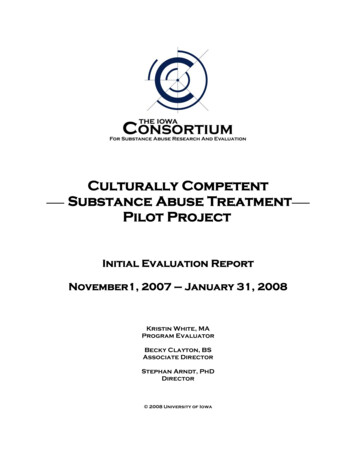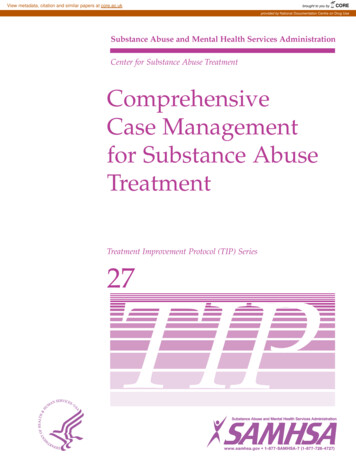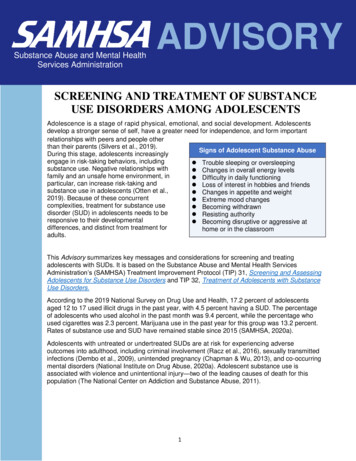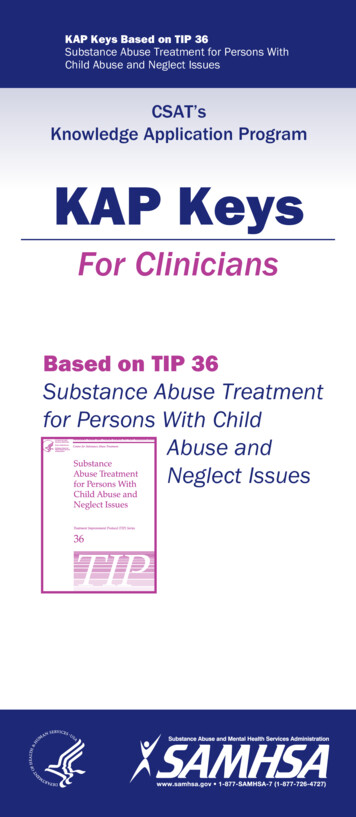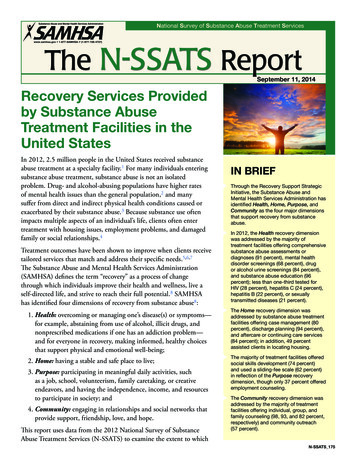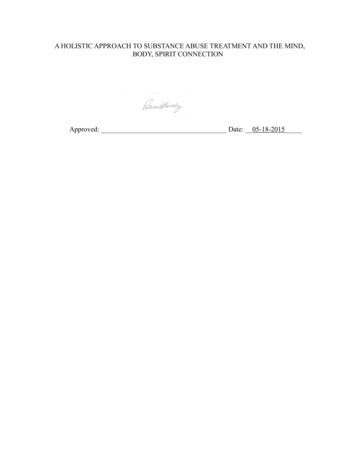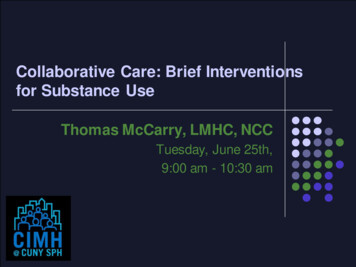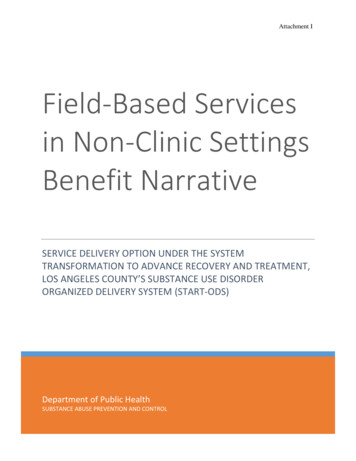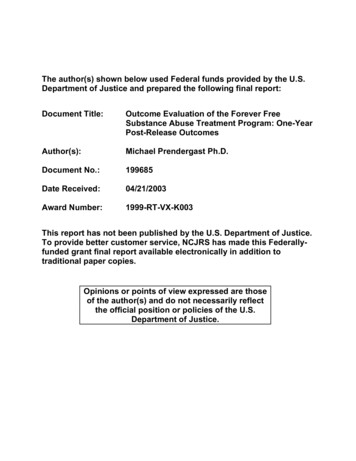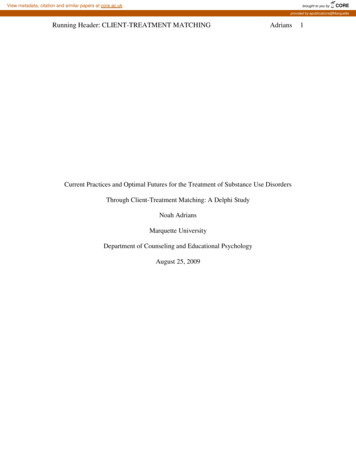
Transcription
View metadata, citation and similar papers at core.ac.ukbrought to you byCOREprovided by epublications@MarquetteRunning Header: CLIENT-TREATMENT MATCHINGAdriansCurrent Practices and Optimal Futures for the Treatment of Substance Use DisordersThrough Client-Treatment Matching: A Delphi StudyNoah AdriansMarquette UniversityDepartment of Counseling and Educational PsychologyAugust 25, 20091
Running Header: CLIENT-TREATMENT MATCHINGAdriansTABLE OF CONTENTSCHAPTER ONE – INTRODUCTION4Statement of the Problem4Study Rationale and Data Collection Procedures7Research Questions10CHAPTER TWO – REVIEW OF THE LITERATURE12Definitions12Client-Treatment Matching Theory Development14Client-Treatment Matching Effects16Client-Treatment Matching Types21Service Matching22Modality Matching24Placement Matching and Patient Placement Criteria30The ASAM Series of Patient Placement Criteria34Evaluating the ASAM and other Patient Placement Criteria38Psychometric Properties of the ASAM-PPC39Theoretical and Conceptual Criticisms of the ASAM-PPC39Counter-Intuitive and Overtreatment Placements41Intra-Level of Care Differences and Non-Linear Matching42Validity and Feasibility with Specific Populations50Literature Summary52CHAPTER THREE: RESEARCH METHODS57The Delphi Approach57The Proposed Study59Appropriateness of the Delphi Approach592
Running Header: CLIENT-TREATMENT MATCHINGAdriansThe Milwaukee Addiction Treatment Initiative as an Expert Panel60The Proposed Research Process61Preparation and Recruitment61Phase One62Phase Two63Phase Three64Timeline65REFERENCES67APPENDICES81Appendix A: Historical Perspectives on Substance Use Disorder Treatment81Appendix B: Development of and Rationale of the Matching Hypothesis 91Appendix C: Ordinal Client-Treatment Matching Effect 197Appendix D: Ordinal Client-Treatment Matching Effect 298Appendix E: Disordinal Client Treatment Matching Effect99Appendix F: Revisions of the ASAM-PPC100Appendix G: Psychometric Properties of the ASAM-PPC104Appendix H: Client-Treatment Matching in other Fields115Appendix I: Core Features of the Delphi Approach118Appendix J: Initial Stimulus and Questionnaire Items126Appendix K: Expert Panel Member Informed Consent1283
Running Header: CLIENT-TREATMENT MATCHINGAdrians4Chapter One: IntroductionStatement of the ProblemApproximately 4 million people in the Unites States aged 12 and over are engaged intreatment for substance use disorders (SUD) each year, according to the 2006 NationalSurvey on Drug Use and Mental Health (Substance Abuse and Mental Health ServicesAdministration, 2007). Among them, 2.5 million individuals received services from an everincreasing range of “specialty services,” including: hospital based inpatient programs,residential rehabilitation programs, outpatient treatment providers, community mental healthcenters, or day treatment, partial hospitalization, or intensive inpatient programs housed inany of the previously described settings. Also, among the 4 million people engaged in SUDtreatment, 2.2 million reported participation in a self-help group (i.e. Alcoholics Anonymous,Narcotics Anonymous), many of whom were simultaneously or had previously been engagedin specialty services.As the diversity in treatment options has grown over time, clients, providers, andpayees have often struggled to identify the optimal treatment program or provider to addressclient needs, as SUD treatments can vary widely on type, philosophy, setting, intensity,activities, services, and cost, amongst other aspects of the therapeutic milieu (Gastfriend &McLellan, 1997; Mee-Lee & Gastfriend, 2008). In efforts to address this concern, methodshave been explored for referring patients to each of the various treatment types, settings, andproviders. These methods include but are not limited to patient self-selection,availability/convenience, random assignment, clinical judgment, or an algorithm or formalplacement rule (Mattson & Allen, 1991). Of these methods, the most widely accepted todayis the use of a formal rule or algorithm, generally in the form of a patient placement criteria(PPC) used to assign a client to a specific setting and intensity of treatment. According toKolsky (2006), 43 states require that some form of PPC be used to assign patients to the
Running Header: CLIENT-TREATMENT MATCHINGAdrians5appropriate level of care (LOC) for SUD treatment. Although numerous PPC exist, asdeveloped by individual states, health care providers, or other organizations, the most widelyused PPC is that of the American Society of Addiction Medicine (ASAM). The ASAM-PPCis approved for use by Value Options and other major healthcare providers, the Departmentof Defense for use in all military bases abroad, and the Veterans Administration for use in its171 hospitals nationwide (Callahan, 1999; Kosanke et al., 2002; Substance Abuse and MentalHealth Service Administration’s Co-Occurring Center for Excellence, 2005; Sharon et al.,2003). Additionally, Kolsky (2006) reports that the ASAM-PPC is required for use in 29states, with additional states requiring the use of either the ASAM or a different PPC (i.e.New York), using PPC either closely based on the ASAM-PPC (i.e. Kansas), or that wereplanning to adopt the ASAM-PPC in the immediate future (i.e. Maine). Additionally, onestate (i.e. Wisconsin) was misrepresented in the study, as Wisconsin statutes allow for the useof either the ASAM or another PPC but was represented in the study as only allowing use ofa PPC unique to Wisconsin. In total, 33 states were found to now use or be in the process ofadopting the ASAM-PPC or another PPC that is only a slight variation from the ASAM-PPC.The ASAM-PPC was first published in 1991 and is now in its second revision, theASAM-PPC-2R (American Society of Addiction Medicine, 1991; American Society ofAddiction Medicine, 2001). The ASAM series of PPC has had tremendous influence over thescience, practice, and policy of assigning clients to SUD treatment, as it has clarified andorganized the process of assigning clients to various settings and intensities of treatment, aswell as having influenced the development of other PPC tools. The ASAM series of PPC hasalso shaped how health care and legal systems, even those not utilizing to the ASAM-PPC,conceptualize patient placement and treatment referral in general. The ASAM series of PPChas also strongly influenced substance use research, Medicaid, individual state treatment andhealthcare systems, and managed care organizations (Kosanke et al., 2001; Sharon et al.,
Running Header: CLIENT-TREATMENT MATCHINGAdrians62003). Congruent with the ASAM-PPC, a priority in modern SUD treatment is typicallyplaced on regulating referral based on the setting and intensity (i.e. hours per week) oftreatment provided within larger treatment systems, while other aspects of treatment notregulated by the ASAM (e.g. services provided, treatment interventions, modalities) are lessclosely attended to in the referral process.Despite the widely accepted nature and prominence of the ASAM-PPC among policymakers and treatment providers, the ASAM-PPC and other currently utilized formal rules oralgorithms for placing clients to a SUD treatment level of care must be recognized as onespecific area of research within a broader body of literature addressing the topic of clienttreatment matching (CTM). In the study of CTM, the chief underlying question pertains towhich treatment, or components of treatment, offer(s) the best outcomes in the most efficientmanner to which clients at which times. Patient placement criteria, such as the ASAM-PPCgenerally attempt to address that question by matching clients to a level of care, characterizedby a specific intensity and setting for treatment (i.e. outpatient, day treatment, residential).However, other approaches to CTM extend beyond matching clients to a treatment settingand intensity. Other approaches include matching clients to specific treatment services (e.g.education, vocation, housing, transportation, child care) (Hser, Polinsky, Maglione, &Anglin, 1999), modalities (e.g. cognitive behavioral therapy, motivational enhancementtherapy) (Project MATCH Research Group, 1997), or other interventions (e.g. individualtherapy, group therapy, anger management). Such additional dimensions and efforts to CTMhave shown broad potential for CTM to enhance client outcomes, increase the potency oftreatment interventions and services, and the improve efficiency/cost-effectiveness of SUDtreatment systems.Theoretically, CTM policies and practices strive to avoid inefficiency in theorganization, delivery, and assignment of treatment components, the consequence of which
Running Header: CLIENT-TREATMENT MATCHINGAdrians7would be a system in which clients have worsened outcomes and need either 1) moreepisodes of treatment or 2) longer stays within each treatment episode to achieve the desiredoutcome. Furthermore, a consequence of poor CTM is that treatment providers would be lesscost-effective as they would be less likely to assign individuals to the minimum effectivelevel and type of treatment, rendering providers less able to offer more treatment options tomore clients. One global outcome of such cumulative systemic inefficiencies is aconsiderable gap between the number of individuals who need and those who actually areable to receive treatment services. According to the most recent information available, of the23.2 million Americans in need of treatment for addiction in a given year, only 10% actuallyreceived treatment (Substance Abuse and Mental Health Services Administration, 2007).This gap also occurs on a local level, as in Milwaukee County, Wisconsin, the region ofinterest for this study, where over 82,000 citizens needed but did not receive addictiontreatment in a given year (Milwaukee Addiction Treatment Initiative, 2009).Study Rationale and Data Collection ProceduresUnderstanding, developing, and refining the potential benefits and practicalimplementation of CTM, through the use of PPC or other methods, to assign clients to a widerange of treatment settings, intensities, services, and other components is critical to thecurrent and future success of the SUD treatment field, both clinically and financially. Issuesassociated with the assessment, matching, referral, and treatment of clients utilizing CTMpractices are paramount for effectively providing treatment to individuals across a wide rangeof interventions, levels, and systems, ranging from the individual clinician to state,community, or regional treatment systems, as well as legislation regulating treatmentpractices. Improvements in CTM practices have been cited as effective in enhancing clientoutcomes, the potency of treatment interventions, and the efficiency in the provision ofaddiction treatment. Increasing the overall effectiveness and efficiency of SUD treatment
Running Header: CLIENT-TREATMENT MATCHINGAdrians8should have broad positive outcomes, including increasing the benefit to individualsparticipating in SUD treatment, potentially reducing both the length of time in treatment andthe need for repeated treatment episodes, as well as making treatment more cost-effective,thereby enhancing the potential quality and availability of treatment.The subject of CTM policies and practices will be explored through a comprehensiveliterature review and iterative survey process exploring expert opinions regarding CTMcurrent practices, needed changes, and optimal states for the treatment field. Thecomprehensive literature review creates context by analyzing the historical origins of SUDand their treatment in the United States. Moreover, the literature review explores thedevelopment of current understandings of best practices in CTM and SUD treatment byoutlining rationale behind the need for and use of CTM practices, theoretical and empiricalresearch about different types, components, and practices of SUD treatment, and how theseaspects of treatment can be potentially enhanced through a structured process of CTM.Survey data will be collected utilizing the Delphi approach, an iterative processseeking to highlight areas of agreement and disagreement among a group of experts in aparticular field. This Delphi study will utilize the pooled expertise of the MilwaukeeAddiction Treatment Initiative (MATI), an organization seeking to address the treatment gapand improve the overall availability, effectiveness, and efficiency in the utilization oftreatment resources in Milwaukee County, Wisconsin, amongst other organizational goals.The MATI includes experts from SUD treatment providers and administrators, along withindividuals from a wide range of relevant partnerships, including public advocacy,government agencies, organized labor, funders, law enforcement/criminal justice, and publicpolicy makers. The MATI has already contributed to significant advances in state and localfunding for SUD treatment and has made initial efforts toward more effectively integratingSUD with mental and physical healthcare systems, as well as with non-health services such
Running Header: CLIENT-TREATMENT MATCHINGAdrians9as housing and employment programs (Community Advocates, 2008; MATI, 2009).Effective use of CTM strategies lies at the heart of efforts, like those by the MATI, towardintegrating previously isolated treatment systems, as well as at efforts to more effectivelyutilize resources, provide appropriate services, and maximize the effectiveness of SUDtreatment. The combined experience, resources, and knowledge housed within the MATI andits partners makes it an excellent resource from which to collect data regarding current andideal treatment practices and systems relating to CTM.By examining combined evidence from the literature review and Delphi survey, acomprehensive assessment of the strengths and weaknesses of CTM science and practice inSUD treatment will be developed, as well as specific recommendations for future directionsin improving the overall effectiveness and resource utilization in SUD treatment. Suchrecommendations, although having immediate relevance to broad areas of policy, practice,and research within SUD treatment fields, will be most directly related to the context ofongoing treatment improvement in Milwaukee County, Wisconsin. It is expected thatknowledge gained in this study regarding CTM in SUD treatment will be of both immediateutility in addressing the SUD treatment gap and SUD treatment system redesign inMilwaukee County, Wisconsin as well as of long-term importance to the broader SUDtreatment field.Information for the literature review was collected through a comprehensivereview of the existing literature related to the treatment of SUD, CTM, and of PPC. Thisreview included systematic searches of online databases, including: Medline, Psychologyin ProQuest, PsychINFO, and the Alcohol Studies Database. Reference sections of allarticles and book chapters were also examined to gather information on both 1) usefulsources that were not found during the initial literature review and 2) the
Running Header: CLIENT-TREATMENT MATCHINGAdrians 10saturation/thoroughness of the existing literature review. Keywords included: substanceuse, substance use disorder, drug addiction, treatment, therapeutic communities,Minnesota Model, level of care, co-occurring disorders, mental health disorder, patientplacement, patient placement criteria, treatment matching, ASAM, addiction treatment,treatment outcomes, and treatment planning. Data was collected regarding the processesand practices of the Delphi methodology by searching reference sections of dissertationsand articles using the Delphi methodology already known to the author (Burkard, Cole,Ott, & Stoflet, 2005; Lombardo, 2007) as well as searches on the previously mentioneddatabases using the keywords, Delphi and Delphi study.Research QuestionsAs previously indicated, CTM strategies have been widely researched for theirutility in enhancing the efficiency and effectiveness of SUD treatment. Moreover, CTMstrategies are widely practiced and are frequently mandated by both private organizationand public institutions, although these mandates and their implementation vary widely.Particularly, CTM by using a PPC to match clients to various levels of care is a widelyimplemented and recognizable form of matching used in SUD treatment. However,multiple questions remain regarding how CTM, including and beyond level of carematching, is implemented both by individual providers and across broader treatmentsystems. Furthermore, questions exist in the literature regarding what ideal CTMpractices are, what barriers exist that restrain ideal CTM implementation, what theimplications of such barriers (and the subsequent CTM deficits) are, and what solutionsexist. Therefore, the primary research questions of this study are as follows (seeAppendix D for the specific questions to be posed to expert participants):
Running Header: CLIENT-TREATMENT MATCHINGAdrians 111. How are CTM strategies and principles being implemented in current, “realworld,” SUD treatment (i.e. by specific providers, within/across treatmentsystems)?2. What are ideal CTM practices?3. What barriers exist that are preventing current CTM practices from taking an idealform?4. What are the implications/negative influences of the barriers (and subsequentimperfect CTM practices) on current SUD treatment and client outcomes?5. What possible solutions exist to overcome barriers to more ideal CTM?
Running Header: CLIENT-TREATMENT MATCHINGAdrians 12Chapter 2: Review of the LiteratureDefinitionsClient-treatment matching: The deliberate and consistent attempt to prescribe treatment onthe basis of individual patient needs, rather than treating all patients with commoncharacteristics or diagnoses the same (Glaser & Skinner, 1981; Mattson & Allen,1991). CTM aims to 1) maximize the effectiveness of specific treatments byidentifiying those individuals most likely to benefit from them, 2) optimize positiveoutcomes for individual clients by matching them to needed treatment elements, and3) improve the effectiveness and efficiency of treatment systems by both maximizingoutcomes while minimizing costs (Gastfriend & McLellan, 1997; Longabaugh et al.1994).Co-occurring disorder(s): These are any medical, mental health, or other diagnosableconditions that coexist with substance-related problems. Depending upon therespective severities of each of a client’s co-occurring substance use, mental health,medical, or other disorders, the client may be best served by receiving primarytreatment in a substance use, psychiatric, or medical facility. However, wherever theclient receives care, providers are recommended to provide services targeted ataddressing all co-occurring disorders in an integrated fashion, rather than treatingonly one problem area (American Society of Addiction Medicine, 2001).Inpatient Treatment: Often delivered in acute or medically monitored medical inpatientsettings, inpatient treatment is the highest intensity treatment available for SUD.These programs include a 24-hour structure of evaluation and treatment providedunder medical direction. Full access to acute medical, psychiatric, and other servicesare available, although the treatment is targeted primarily for the treatment of SUD(American Society of Addiction Medicine, 2001).Intensive Outpatient: A level of care for SUD treatment serving patients needing intensivetreatment programming but who do not need 24-hour supervision or access toservices and can generally succeed in treatment on an ambulatory basis. Intensiveoutpatient services generally involve 9 – 19 hours of structured programming eachweek. Intensive outpatient programs are also commonly referred to as “daytreatment” (American Society of Addiction Medicine, 2001).Level of care: Levels of care represent SUD treatment options organized along a continuumof program levels, each targeted to meet client needs based on the setting andintensity of treatment services provided. The optimal level of care is considered to bethe least intensive treatment level capable of facilitating client change, meetingtreatment objectives, and providing appropriate supervision and security for theclient. Beliefs regarding the optimal level of care indicate that receiving services at alower than recommended level will facilitate worsened treatment outcomes, whilereceiving services at a higher than the needed level will not enhance outcomes butrather represents an unnecessary expense and inefficient use of resources (AmericanSociety of Addiction Medicine, 2001).
Running Header: CLIENT-TREATMENT MATCHINGAdrians 13Outpatient Treatment: A level of care for treatment providing evaluation, treatment, andrecovery services designed to help an individual change alcohol- and drug-use, aswell as other maladaptive behaviors or conditions. Treatment is provided on anambulatory basis and consists of regularly scheduled sessions, at an intensity that(usually) involves fewer than nine hours of service a week (American Society ofAddiction Medicine, 2001).Overtreatment: This condition occurs when a client receives services at a higher intensitylevel of care than is needed to facilitate optimal client outcomes. Overtreatmentconditions do not further enhance treatment outcomes, but rather representunnecessary expenses and an inefficient use of payee, provider, and client resources(Magura et al., 2003).Partial hospitalization: A level of care for SUD treatment serving patients needing intensivetreatment programming but who do not need 24-hour supervision or access toservices and can generally succeed in treatment on an ambulatory basis. Partialhospital programs generally provide 20 hours of structured programming eachweek. Partial hospitalization programs are also commonly referred to as “daytreatment” (American Society of Addiction Medicine, 2001).Patient placement criteria (PPC): Patient placement criteria are theoretically and empiricallysupported clinical decision trees or algorithms, which serve as structured guidelinesfor conducting a multidimensional assessment of and assigning patients to a specificlevel of care. Patient placement criteria are thought to enhance the treatment ofsubstance use and other co-occurring conditions by placing clients in a treatmentsetting and service intensity capable of optimizing outcomes in the most efficient (i.e.cost effective) manner possible.Residential Treatment: A level of care for SUD treatment serving patients in need of 24-houra day supervision and access to services. Clients in residential treatment need safeand stable living environments in which to develop the attitudes, skills, behaviors,and other changes necessary to fulfill the goals stated in the treatment plan.Residential treatments encompass a range of intensities, including clinically managedlow, medium, and high intensity programs that differ on the number and intensity ofservices provided to clients while they remain engaged in residential treatment(American Society of Addiction Medicine, 2001).Undertreatment: Undertreatment conditions are thought to exist when clients receive servicesat a lower intensity level of care than is recommended. Receiving services at a lowerintensity level of care than needed, although generally constituting a reduction in theup front cost of services, is generally thought to lead to worse substance use, mentalhealth, and other client outcomes. Undertreatment conditions have also beendemonstrated as leading to increased future service utilization, also causingundertreatment to rather represent unnecessary expenses and an inefficient use ofpayee, provider, and client resources (Magura et al., 2003).
Running Header: CLIENT-TREATMENT MATCHINGAdrians 14Client-Treatment Matching Theory DevelopmentAlthough many programs, models, and settings for substance use disorder (SUD)treatment have existed over time, comprehensive, residential, high intensity treatments (e.g.Minnesota Model programs for alcohol, Synanon and therapeutic communities for drug use)dominated the SUD treatment field through the 1970s and into the 1980s. These modelsrepresented advancements in treatment field as they provided conceptualizations andtreatments reflecting SUDs as “chronic diseases that have multiple etiological roots, multipledimensions in their symptomatology, and which are characterized by episodes of remissionand relapse” (White, 1998, p. 212). The degree to which such comprehensive, high intensity,residential programs were effective as the treatment of choice for most clients entering SUDtreatment has been well documented for therapeutic communities and Minnesota Modelprograms over time. Marlatt and Gordon (1985) stated that approximately 90% of individualswho complete treatment in therapeutic communities remain abstinent on a “long-term basis”,although only small percentages, frequently as low as 20%, actually complete treatment.Early reports of Minnesota Model programs indicate that approximately 30% of participantsattained a prolonged abstinence at six-month follow-up, 24% demonstrated notable reductionin alcohol use although they had not maintained complete abstinence, and another 30% ofclients were drinking at follow-up, although with significant reductions in the negativeeffects associated with alcohol use (White, 1998) (see Appendix A for an extended review ofsubstance use and SUD treatment in American history).Despite empirical and anecdotal evidence supporting the overall effectiveness of highintensity treatments following the Minnesota Model (Cook, 1988) and therapeuticcommunities (Borkman et al., 2007; De Leon, 1989; White, 2005), evidence demonstratedthat other models, settings, and intensities of treatment for SUD offered comparable
Running Header: CLIENT-TREATMENT MATCHINGAdrians 15outcomes among unmatched or randomly assigned samples of individuals entering treatment.These findings led questioning of the necessity and appropriateness of traditional approachesin which all clients were enrolled in uniform, intensive, inpatient or residential treatments(i.e. Minnesota Model, therapeutic communities, narcotics farms). Multiple factorscontributed to a gradual shift away from traditional patterns of placing all clients in highintensity residential or inpatient programs.Among these factors was a shift from indemnity to managed care among payees forSUD treatment, which called for greater efficiency in the utilization of treatment resourcesand reductions in treatment cost where possible (Gastfriend & McLellan, 1997). Also,evidence that lower intensity treatments offered financial incentives for client and provider asthey generally cost only 40 – 60% as much, required considerably less time, and were lessdisruptive to the client’s life than more intensive treatments pushed the treatment field toexplore elements of CTM (Alterman, O’Brien, McLellan et al., 1994; Annis, 1986).Additionally, CTM practices were aided by research demonstrating the lack of absolutedifferences in outcomes for unmatched or randomly assigned clients across various treatmentsettings and intensities (i.e. outpatient, day treatment, residential, inpatient) (Annis, 1986;Guydish, Werdegar, Sorensen, Clark, & Acampora, 1998; Longabaugh, Wirtz, DiClemente,& Litt, 1994; Mattson & Allen, 1991; Miller & Hester, 1986; Rychtarik et al., 2000). Finally,the development and accumulation of evidence toward the “matching hypothesis,” (i.e.treatment outcomes can be augmented by matching specific clients to specific treatmentsbased on an understanding of how interactions between client- and provider-level variablesimpact client outcome beyond what would be accounted for in the main effects of treatmentbest practices) showed that CTM could not only save money but could also improvetreatment. Many factors in this shift are based on the established premise that althoughtreatment for substance use disorders is generally effective in promoting change for most
Running Header: CLIENT-TREATMENT MATCHINGAdrians 16individuals, no single treatment has been shown effective in maximizing positive outcomesfor all individuals or better than other treatments in all circumstances (Gastfriend & Mee-Lee,2004) (see Appendix B for an extended review of the development of and rationalesupporting the matching hypothesis).Client-Treatment Matching EffectsA gradual accumulation of evidence regarding the possibilities of client-treatmentmatching (CTM), motivated by a need to find a more cost-effective means of providing SUDtreatment and by evidence that no single treatment met the needs of every client, played acentral role in the shift away from assigning all clients to high intensity treatments. This shiftgradually led the SUD treatment field toward efforts to individually match each client to atreatment option seen as best suited to address each person’s unique needs. In examining theprinciples of CTM, authors state that it is important to: 1) note the interest(s) served by CTMresearch, 2) discriminate between different types of CTM interactions, and 3) distinguisheffects of CTM from the main effects of treatments themselves (Allen, Babor, Mattson,Kadden, 2003; Longabauch, Wirtz, DiClemente, & Litt ,1994; Mattson & Allen, 1991).Longabauch and colleagues (1994) identified three primary motivations for matchingresearch. The first motivation for studying a matching interaction is the maximization of theeffectiveness of a specific treatment setting, intensity, or intervention (i.e. cognitivebehavioral therapy, medically monitored inpatient) by identifying and assigning clients to itwho would be most likely to benefit. The second motivation is the ability to focus on aspecific client variable (i.e. presence of co-occurring disorders, gender) in an effort toidentify the optimal treatment conditions for clients with that characteristic. The thirdmotivation for matching research is the opportunit
2003). Additionally, Kolsky (2006) reports that the ASAM-PPC is required for use in 29 states, with additional states requiring the use of either the ASAM or a different PPC (i.e. New York), using PPC either closely based on the ASAM-PPC (i.e. Kansas), or that were planning to adopt the ASAM-PPC in the immediate future (i.e. Maine).
